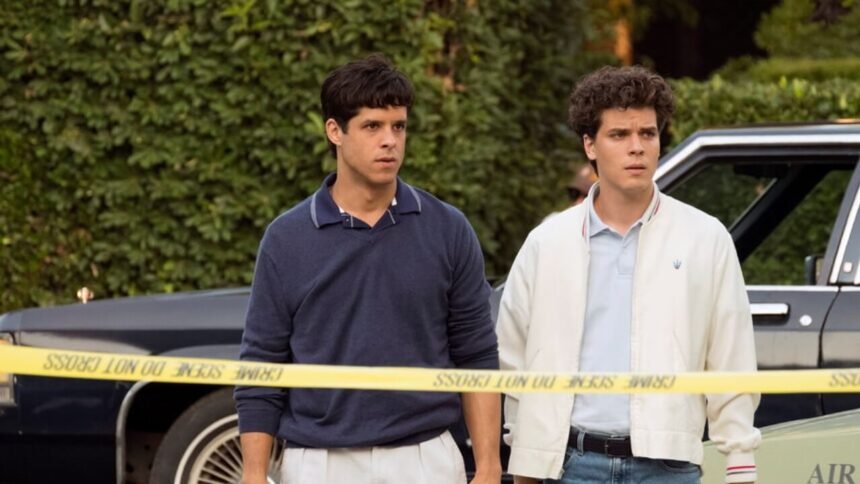The Menendez crime scene photos have become a chilling and iconic element in one of the most sensational criminal cases in American history. These graphic images, released during the trial of Lyle and Erik Menendez, provide a haunting glimpse into the grisly realities behind the shocking murder of their wealthy parents in a Beverly Hills mansion. For Americans intrigued by true crime, understanding the role these photographs played in the trial—and the story they tell—opens a window into legal strategy, forensic science, and the complex psychology behind a notorious double homicide.
The Menendez Crime Scene Photos: Impact and Controversy
When the prosecution displayed the Menendez crime scene photos to the jurors, the impact was profound and immediate. The images depicted the brutal shotgun wounds inflicted on Jose and Kitty Menendez, showing, in vivid detail, the horror of the attack. Lyle and Erik were visibly shaken during the introduction of these images, some with tears in their eyes, reflecting the emotional weight these photos carried in the courtroom. The photos revealed how Jose Menendez was struck six times, including a fatal contact wound to the back of his head, and how Kitty Menendez suffered ten shotgun blasts, including injuries to her face and chest. This presentation was strategic, as prosecutors sought to underscore the violent nature of the crime to support charges of first-degree murder. However, defense attorneys argued these photos were excessively “bloody and gruesome,” aiming to sway jurors through emotion rather than facts. The judge ruled in favor of allowing them, concluding the photos were critical evidence rather than undue gore.
Forensic Insights from the Crime Scene Photos
Beyond their emotional effect, the Menendez crime scene photos provided essential forensic evidence that helped reconstruct the crime’s sequence. The deputy medical examiner who performed the autopsies, Dr. Irwin L. Golden, testified that the photos showed multiple entry wounds on the victims, with shot angles suggesting they were at least partially standing and moving during the attack. The evidence indicated a frenzied, sustained onslaught rather than a rushed incident. The photos also helped clarify contentious points about whether the brothers reloaded their weapon and the sequence of fatal shots, demonstrating that Jose Menendez died “immediately or rapidly” after the contact shot to the back of his head, likely the shooting’s final act. These forensic revelations were pivotal in framing the incident as a cold-blooded and deliberate murder from the prosecution’s standpoint.
Psychological and Legal Dimensions Behind the Menendez Crime Scene Photos
The crime scene photos also became emblematic of the complex psychological narratives at the heart of the Menendez trial. The defense’s case rested heavily on claims that the brothers acted in self-defense after enduring years of physical, mental, and sexual abuse from their parents. Psychologist L. Jerome Oziel, who testified as an expert witness, argued that such trauma could explain the brothers’ actions and emotional breakdowns in court, particularly their reactions to the crime scene images. As Oziel stated, “The photos served not only as legal evidence but also as a painful reflection of the cycle of violence and fear that enveloped this family.” His insight highlighted the layered reality that the photos symbolized: evidence of brutal violence, but also a trigger for understanding the abuse allegations and psychological damage the brothers claimed.
Public and Cultural Reactions to the Menendez Crime Scene Photos
The Menendez crime scene photos fueled extensive public fascination and media coverage, becoming a reference point for why the trial captured national attention. These images have been featured in news reports, documentaries, and true crime retrospectives, reinforcing the case’s grim reality for audiences. For many Americans, the photos epitomized the dark side of wealth, fame, and family dysfunction. The graphic nature provoked debates about the ethics of displaying crime scene photos in trials and media, balancing the public’s right to know against the risks of sensationalism. Moreover, their release influenced public opinion on the case, with some viewers seeing unspeakable cruelty and others contemplating the possibility of a tortured background that led to the crime.
Conclusion: The Enduring Legacy of Menendez Crime Scene Photos
The Menendez crime scene photos remain a powerful testament to one of America’s most infamous criminal cases. Their role transcended mere documentation; they shaped courtroom dynamics, forensic understanding, psychological interpretation, and public perception. Through these haunting images, Americans continue to grapple with questions about justice, trauma, and the human capacity for violence. As the decades pass, the Menendez case—with its crime scene photos as a grim focal point—still evokes reflection on how raw, unfiltered evidence can tell the complex story behind a shocking crime.
you may also like
Exploring the World of True Crime Museums: A Fascinating Journey into History’s Darkest Corners






